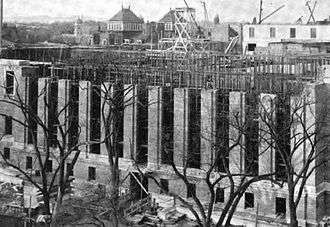Library stack
In library science and architecture, a stack or bookstack (often referred to as a library building's stacks) is a book storage area, as opposed to a reading area. More specifically, this term refers to a narrow-aisled, multilevel system of iron or steel shelving that evolved in the nineteenth century to meet increasing demands for storage space.[3] An "open-stack" library allows its patrons to enter the stacks to browse for themselves; "closed stacks" means library staff retrieve books for patrons on request.



Early development
French architect Henri Labrouste, shortly after making pioneering use of iron in the Bibliotheque Sainte-Genevieve of 1850, created a four-story iron stack for the Bibliothèque nationale de France.[4] In 1857, multilevel stacks with grated iron floors were installed in the British Library.[3] In 1876, William R. Ware designed a stack for Gore Hall at Harvard University.[1] In contrast to the structural relationship found in most buildings, the floors of these bookstacks did not support the shelving, but rather the reverse, the floors being attached to, and supported by, the shelving framework. Even the load of the building's roof, and of any non-shelving spaces above the stacks (such as offices), may be transmitted to the building's foundation through the shelving system itself. The building's external walls act as an envelope but provide no significant structural support.[4]
Fisher Fine Arts Library at University of Pennsylvania, designed by Frank Furness was the first library in United States of America to incorporate stacks as part of original design and separated the low ceilings of the library stack, where the books were stored, from forty foot plus high ceilinged rooms, where the books were read and studied (see https://m.youtube.com/watch?v=hWOH42D3i1U which takes you to YouTube video of history of Penn architecture). The cornerstone of first building at Penn solely used as a library was laid in October 1888, construction was completed in late 1890, and the building was dedicated in February 1891.(See Applications for Historical Landmark Status- http://uchs.net/HistoricDistricts/furness.html Accessed July 20, 2007.)
Library of Congress and the Snead system
For the Thomas Jefferson Building of the Library of Congress, completed in 1897, Bernard Richardson Green made a number of alterations to the Gore Hall design, including the use of all-metal shelving. The contract was won by the Snead and Company Ironworks, which went on to install its standardized design in libraries around the country.[1] Notable examples include the Widener Library at Harvard and the seven level stack supporting the Rose Reading Room of the New York Public Library.[3]
The Library of Congress bookstacks were designed and patented by Bernard R. Green (1843-1914), the engineer in charge of the Library of Congress construction, where this type of book storage was first used. Although the structure was of cast iron, the shelves were made from strips of thin U section steel, designed to be as light as an equivalent pine shelf. The top surface of the U section was ground, polished and 'lacquered' (the constituents of the lacquer are not known). Green designed the stacks to be modular, able to be erected several stories high as a single freestanding structural entity incorporating staircases and floors, and even capable of supporting a roof structure. He designed the shelves so that they could adjust to book sizes using a simple lug system without the need for any bolts or fixings. Although the bookstacks were decorated and very simply embellished, they are of machine-age industrial design.[5]
Stacks were typically envisioned for access by library staff fetching books for patrons waiting elsewhere, and so were often built in ways making them unsuitable for public access. Increasing concern with opening stacks to the public,[4] the desire to construct buildings adaptable to changing uses,[3] and concerns over the feasibility of storing truly comprehensive collections of books contributed to the decline of the Snead stack. Angus Snead Macdonald, president of the Snead Company from 1915 to 1952, himself advocated for the transition to modular, open plan libraries in the mid twentieth century.[4]
Forms
For closed stacks, mobile shelving may be used to minimize floor space. With computerized indexing, filing by book size saves up to 40% space as well.[6]
See also
References
- Snead Company (1915). Library Planning Bookstacks and Shelving. Architecture Press. pp. 11–12, 152–158.
- Lane, William Coolidge (May 1915). "The Widener Memorial Library of Harvard College". The Library Journal. 40 (5): 325.
- Petroski, Henry (1999). The Book on the Book Shelf. Alfred A. Knopf. pp. 167–168, 170–172, 184, 191.
- Wiegand, Wayne, ed. (1994). Encyclopedia of Library History. Garland. pp. 352–355.CS1 maint: extra text: authors list (link)
- "Snead cast iron bookstack features at Hindman's Chicago sale (18 November 2018)". salvoweb.com. Retrieved 2018-11-20.
- Quito, Anne (13 October 2016). "The New York Public Library has adopted a very unusual sorting system". Quartz (publication). Atlantic Media. Retrieved 13 October 2016.